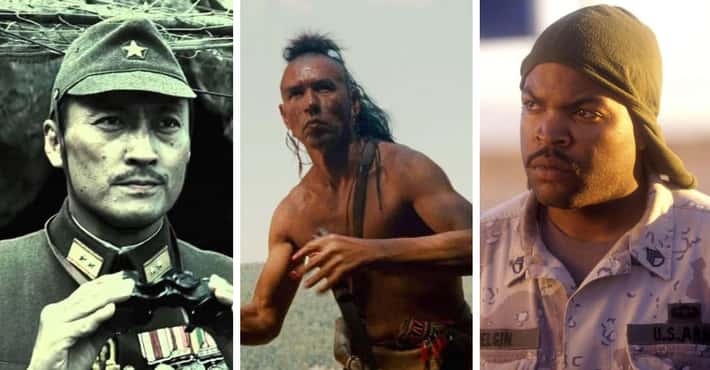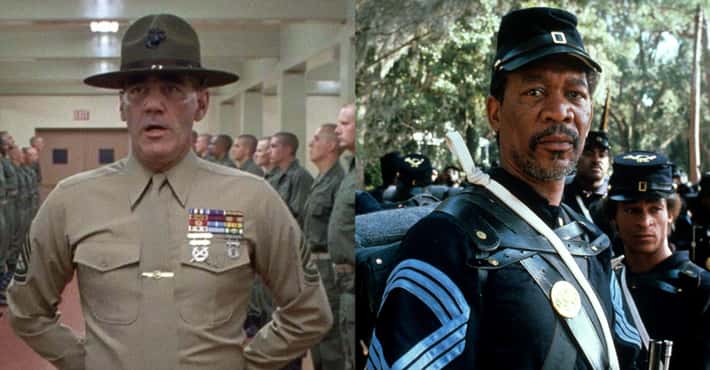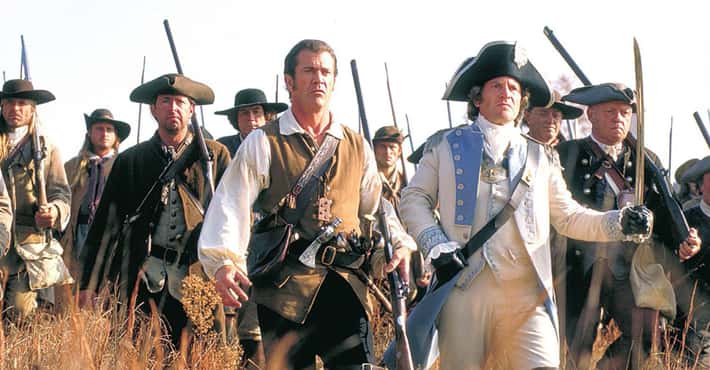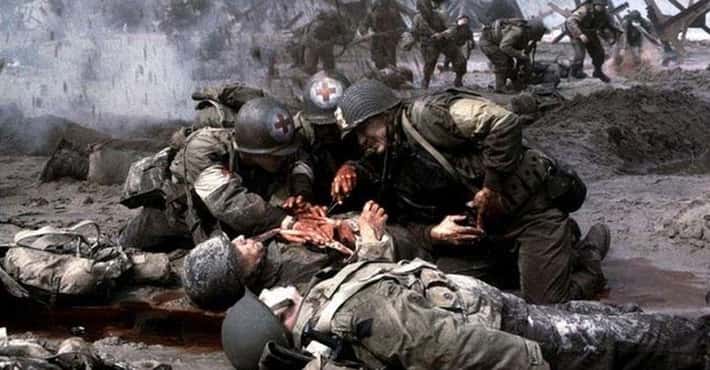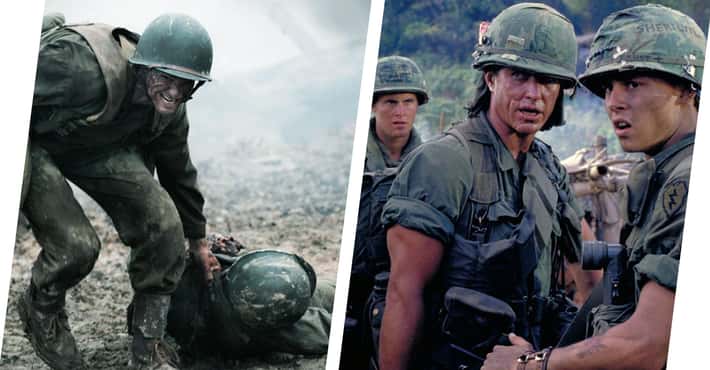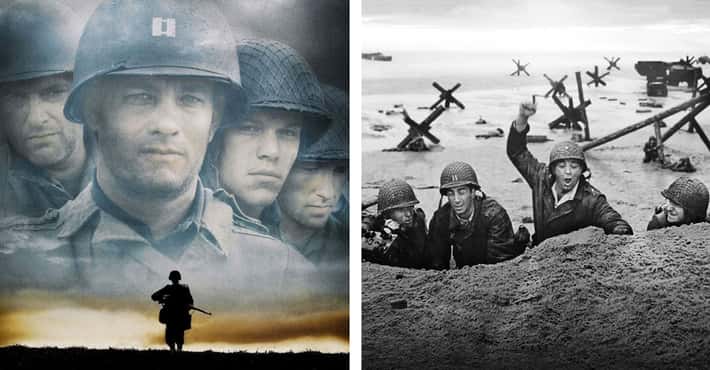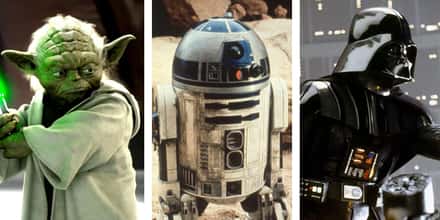
- Photo:
- Saving Private Ryan
- DreamWorks Pictures
The Historical Details Behind Every Weapon Seen In 'Saving Private Ryan'
Copy link
Vote up the weapons with the most impactful stories.
The uncompromising brutality of Saving Private Ryan’s depiction of World War II still hits just as hard today as it did when it was released back in 1998. It's a far cry from the sanitized depictions of the conflict that came before it, and Steven Spielberg and crew worked diligently to honor veterans with an authentic portrayal. Although a few departures from recorded history for the sake of the narrative take place, and a few minor quibbles about the equipment exist, the film’s attention to detail is admirable.
The events take place deep in the conflict, and we see a variety of great and terrible weapons fielded by both the American and German forces. From the makeshift explosives to “Hitler’s buzzsaw,” this collection looks at the real history behind every weapon seen in Saving Private Ryan.
- Photo:
158 VOTESRaketenpanzerbüchse (RPzB) 54
The German answer to the American bazooka, the RPzB 54 - or simply Panzerschreck (“tank's bane” or “tank's fright”) - was modeled from bazookas captured by the Germans in 1943. Its most distinguishing feature was the metal blast shield to protect the operator.
Though primarily used as an anti-tank weapon, the 88mm rocket could work against softer human targets, as the movie shows. One round is enough to send one unfortunate paratrooper flying into a ground-floor window.
- Photo:
2107 VOTESM2 Mortar
The M2 Mortar used by the US in WWII (and up to the 1970s) was licensed from the French Brandt company, makers of the first-rate Brandt Mle 27/31. The simple tube design has changed very little since its inception in the 1920s; capable of firing an array of shells up to 1.7 miles, it's been the ideal infantry support weapon for more than a century.
Of course, in Saving Private Ryan, we don’t actually see the M2 Mortar used as intended. In the final moments of the last stand at Ramelle, a desperate Pvt. James Ryan and Capt. John Miller have to improvise by throwing mortar shells by hand.
These ad hoc grenades might not have the range of the M2, but they work well enough in combat. Interestingly, there was a real instance of an American using mortar shells as makeshift grenades - Corporal Charles “Commando” E. Kelly did just that in Italy in September 1943 and won the Medal of Honor for his actions.
- 3124 VOTES
The weapon’s peculiar nickname was inspired by the novelty musical instrument invented and used by the film and radio personality Bob Burns. When the US entered WWII, it was clear that a tactical anti-tank weapon was necessary.
One of the first design obstacles was figuring out how to make it work without getting propellant in the soldier’s face when fired. The story goes that designer Edward Uhl saw tubes in a scrap heap and realized the solution - make it shoulder-mounted. The bazooka was simple to operate and was an immediate success in trials; some 450,000 were made over the course of WWII.
The bazooka proved incredibly effective in the field, and after the war, Dwight D. Eisenhower, the Supreme Commander of Allied Forces and future US President, hailed it as one of the “four tools of victory.” The others were the C-47 transport plane, the atomic bomb, and the Jeep.
In Saving Private Ryan, Pvt. James Ryan takes out a German half-track with a bazooka when Capt. John Miller’s squad first catches up with him. At Ramelle, Sgt. Mike Horvath takes out a Marder III tank destroyer with a well-placed shot to its vulnerable rear. The third and final use seen in the movie is less successful - a frontal shot against a “Tiger” tank, which has no effect.
- Photo:
477 VOTESM1 Flamethrower
Flamethrowers were far from new weapons in WWII; they were used by the Germans, and to a lesser extent the French, in WWI - with terrifying effects. Just as in the Great War, flamethrowers were most useful in WWII for smoking out enemies in entrenched positions. While ghastly injury and death could and did happen to those unfortunate enough to be struck by the jets of fire, the most common application of a flamethrower was usually to incapacitate rather than kill outright.
The American M1 flamethrower was unreliable and prone to fuel leakage and ignition failures, leading to the development of the improved M1A1 and later M2. Flamethrowers weren’t used a great deal in Europe after Normandy, but were widely used in the Pacific Theater.
In Saving Private Ryan, we see one operator set alight when his tank is struck by a bullet. A common trope in movies and video games, it actually wasn’t all that likely that small arms fire could ignite a fuel tank (unless it was an incendiary round). We also see flamethrowers clear out a bunker, with the unfortunate defenders left to burn alive.
- Photo:
577 VOTESM1918A2 Browning Automatic Rifle (BAR)
The M1919A2 Browning Automatic Rifle, known simply as the BAR, was a 1940 update to the original 1918 model that debuted in that year. The BAR was a light support weapon for providing firepower on the move. It packed a punch but came with some major drawbacks - its magazine held just 20 rounds, so it could be emptied in only 4 seconds, and its barrel was fixed, meaning it was prone to overheating. Army doctrine at the time assigned one BAR per platoon and trained every man on it. At first, it was used by a team of three, but by 1944 it was a one-man job.
Normally the A2 came with fixed bipods that added to its considerable weight (21 pounds), but Pvt. Richard Reiben’s (Edward Burns) weapon has its bipods removed. This is perhaps why he can fire it from the shoulder without too much difficulty (or just the fact it’s a lightweight replica).
- 6111 VOTES
The M1 Garand is seen throughout Saving Private Ryan, as it was the standard-issue service rifle of the US Army at the time, first entering service in 1937. Around the time the movie takes place (1944), the US was pumping out 165 Garands every hour. The American rifle had a major edge over its contemporaries in that it was semi-automatic rather than bolt-action, meaning it had a much greater rate of fire. It could also be mounted with an M7 grenade launcher.
Once described by General George S. Patton as “the greatest battlefield implement ever devised,” the M1 Garand’s accuracy, reliability, and rate of fire made it a first-class weapon of WWII.
Several neat little details exist in the movie - it gets the Garand's signature “ping” sound made when firing the last round just right. Secondly, during the grave-digging scene, Capt. John Miller pulls out the trigger grouping of the rifles used to mark a GI grave so they can’t be used by the Germans. The M7 grenade launcher is also briefly seen in the closing moments of Omaha Beach.
- 796 VOTES
The Colt M1911A1 was a sidearm used by the US military for more than a century. First designed by John Moses Browning back in 1911 (hence the name), the semi-automatic used a new cartridge that was more reliable and had greater stopping power than the earlier M1902, whose shortcomings were exposed during the Philippine-American conflict.
The M19111 was used successfully in both world wars, with just under 2 million produced for service in the latter. In Saving Private Ryan, we see it in action a few times, most notably in Capt. John Miller’s final moments, when he fires a few futile rounds at an oncoming “Tiger” (actually a dressed-up T-34 tank, a frequent movie stand-in for the Tiger).
- Photo:
857 VOTESWalther P38
The Luger might have been one of the most prized war trophies for American soldiers, but it wasn’t the standard sidearm for the Wehrmacht in WWII. That distinction belonged to its intended replacement - the Walther P38. Designed in 1938, it didn’t enter full production until after 1940. Lugers were still in production as late as 1943.
In Saving Private Ryan, we only get a quick glimpse of a P38 when Sgt. Mike Horvath and a German soldier fight at close quarters. Horvath dispatches his assailant, but is wounded in the action.
- 964 VOTES
The M1A1 Thompson used by Capt. John Miller and a few other soldiers in the film was an improved version of the submachine gun designed by US Army Brigadier General John T. Thompson. He originally envisioned a device for clearing the trenches of WWI and completed a design in 1918, but since the Great War was over by then, a prototype was never made.
Versions of the Thompson finally came to market in the 1920s. Although the military was initially uninterested, the device gained notoriety through its use by gangsters and law enforcement in the Prohibition era. The 1928 model was deemed both too heavy for combat and too expensive for mass production, so a simplified version, the M1, was born. The most notable difference was replacing the old 50-round drum with lighter box magazines that typically held 20-30 rounds; it also used a straight blowback action rather than the delayed blowback of earlier models.
The M1A1 was introduced in 1942 with a more cost-effective design than the M1 by the time the film takes place; Thompsons cost just $45 a piece at the time - or $780 in 2023 dollars.
- Photo:
1095 VOTESM1A1 Bangalore Torpedo
Bangalore torpedoes were first devised by Captain R.L. McClintock, a British officer serving in Bangalore, India (hence the name) way back in 1912. They were intended as tools for combat engineers (also called sappers) to clear anti-personal mines at a relatively safe distance of 10 feet. In WWI, the military realized the Bangalore torpedo could also do a decent job of creating breaches in barbed wire and other anti-personnel barriers.
The devices were adopted by the US during WWII and used on D-Day to create gaps in the barbed wire - just as shown in the film. Versions of the Bangalore torpedo are still used in modern times. (The city in India is now called Bengaluru, its native name).
- 1178 VOTES
The MG42, known as “Hitler’s buzzsaw,” was the most effective machine gun of WWII by a distance. A successor to the already formidable MG34 (which sharp-eyed viewers can see mounted to one of the panzers in the Ramelle battle), the MG42 was more portable, reliable, and could fire an astonishing 1,200 rounds a minute (some versions could go up to 1,800). To cap it all off, its dreadful sound had a psychological effect on anyone unfortunate enough to come up against it.
War Office propaganda reels tried to assure Allied troops going into D-Day that the MG42’s “bark was worse than its bite,” and that although it could spit out lots of bullets and make a great racket, it wasn’t terribly accurate at range. That comforting lie was quickly exposed just as the movie’s visceral opening scene shows. The MG42 mowed down Allied troops in droves; the majority of casualties on June 6, 1944 were at Omaha Beach in the first waves that landed. It was only after Hitler’s buzzsaw was silenced that any headway could be made.
We see that terrible weapon again later when Capt. John Miller’s squad takes on a machine gun nest that claims the life of Irwin Wade (Giovanni Ribisi), the combat medic.
- 1255 VOTES
The US entered WWII without either a dedicated sniper rifle or a training program for the next generation of sharpshooters. The ad hoc solution was to repurpose the Springfield M1903 - the standard-issue rifle before the M1 Garand was introduced - under the name M1903A4. The iron sight was swapped for a telescopic scope mounting; the standard scope was a Weaver 330C, though the US Marines made use of Unertl scopes in the Pacific Theater.
In Saving Private Ryan, Pvt. Daniel Jackson has somehow gotten his hands on both a Lyman Alaskan and a Unertl scope, which wouldn’t have been readily available in the European Theater.
- Photo:
1346 VOTES2cm Flak 38
The 2cm Flak 38 makes a brief but brutal appearance in the film when it tears through an exposed squad atop a disabled tank; the large caliber shells make mincemeat of the unfortunate troops. The weapon was normally used to bring down enemy aircraft and actually began its service life mounted to aircraft used by German volunteers in the Spanish Civil War.
It wasn’t unusual for German AA guns to be turned against ground targets. In the Normandy campaign, the Flak 38 was occasionally turned against infantry, while the larger 8.8cm Flak 37 doubled as an effective anti-tank device when the situation called for it.
- Photo:
1470 VOTESM1 Bayonet
The demise of Pvt. Stanley Mellish (Adam Goldberg) is one of the most disturbing of all in a film chock-full of miserable ends. The original conception was apparently even worse. His own blade, which finished him off, appeared to be an M1 bayonet, introduced in 1943 and first used in combat during the Normandy campaign.
The M1 was a newer version of the older M1905 bayonet, and more or less identical save for its length. Indeed, some soldiers were actually issued with an M1905E1, which was simply an M1905 with a shortened blade.
- 1544 VOTES
The M1 and M1A1 Carbine both appear in Saving Private Ryan; the former is wielded by Sgt. Mike Horvath (Tom Sizemore), while the latter, recognizable by the folding metal stock, is carried by some of the paratroopers. The M1 Carbine was a smaller and shorter weapon developed two years after the M1 Garand.
The concept for the smaller weapon was first worked on by Jonathan “Ed” Browning, brother of John Moses Browning, but Ed passed before the prototype was complete. David Marshall “Carbine” Williams, a moonshiner and convicted criminal who discovered a knack for weaponsmithing while behind bars, finished the work.
The M1 Carbine was envisioned as a weapon for non-combat troops, for whom the heavier M1 Garand was impractical. It was to be a self-defense weapon for support troops if they came under fire, but wasn’t initially intended as a frontline weapon. Its innovative lightweight design was a hit with the men, though its smaller caliber rounds lacked the stopping power of the Garand. It was often carried by non-commissioned officers, so it was appropriate to see Sgt. Horvath with one, just as the lighter M1A1 was issued to paratroopers in the Army's 82nd and 101st Airborne divisions. Some 6 million M1 Carbines were manufactured during WWII.
- Photo:
1667 VOTESM24 Stielhandgranate
The visually distinctive German grenade used in WWII was an upgrade of the WWI model nicknamed the “potato masher” by the British, a moniker that stuck for the second conflict. The most commonly used grenade in WWII was designed in 1924; a later upgrade came in 1943, but the M24 was used throughout the conflict.
The “stick hand grenade” (the translation of stielhandgranate) differed in appearance and also functioned a little differently from the round bombs thrown by the Allies. Users ignited the fuse by pulling a cord at the bottom, and the explosion was concussive rather than fragmentary. In simple terms, this meant it was a straightforward explosive thrown ahead of an attack to incapacitate the enemy.
The stick grenade was more accurate than round grenades because once thrown, it pretty much stayed where it was, while Allied grenades were naturally prone to rolling around. The movie demonstrates the M24’s main shortcoming - it was fairly easy to spot and return to sender, as soldiers Mellish and Henderson manage to do in battle.
- Photo:
1781 VOTESKarabiner 98K
The weapon that mortally wounds Capt. John Miller, the Karabiner 98K, was the standard-issue rifle for Germans in WWII. Usually known simply as the Kar98K, it first entered service back in 1935 and was used widely throughout the conflict. A bolt-action rifle, it was a generally reliable service weapon, but was simply outclassed by the American M1 Garand by the latter stages of the conflict. In late 1944, the Germans introduced a streamlined Kriegsmodell ("war model") of the Kar98K for increased output with rapidly diminishing resources.
The weapon could also be fitted with telescopic sights for use as a sniper rifle. The German sniper who takes out Adrian Caparzo (Vin Diesel) was armed with a Kar98K fitted with a 4x Zeiss ZF42 sight. That sniper's demise - being shot through his own scope - actually has some basis in reality, albeit from a different conflict. American sniper Carlos Hathcock took out an enemy sniper by firing a round through the enemy's telescopic sight during the Vietnam War.
- Photo:
1876 VOTESSticky Bombs
When confronting the problem of how to deal with German tanks, Capt. John Miller suggests a sticky bomb and assures his perplexed men that “it’s in the manual.” It isn’t, but to address the first question, were sticky bombs real, and were they actually used in WWII? The answer is “kind of.”
An ad hoc anti-tank grenade that worked by sticking to enemy armor was indeed manufactured in great quantities during the war, but not by Americans. The sticky bomb - or Grenade, Anti-Tank, No. 74 Mk1 to give its proper name - was made by the British. This was after the Dunkirk evacuation, and anti-tank weapons of any sort were needed quickly to fend off an invasion.
The British sticky bombs had some serious flaws, one being that they didn’t really stick to tanks that were muddy or wet, which would be a bit of a problem for use in Britain. What they did stick to were the uniforms of the men using them; one Home Guard soldier got a bomb stuck to his trousers and somehow managed to get it away from him - with his trousers still stuck - before the device detonated. The bombs were inaccurate to throw, so some soldiers opted to run up and manually attach them to tanks, at huge risks to themselves. We see an element of that danger in the movie, when one soldier holds his bomb too long and is unceremoniously blown to pieces.
Despite some serious misgivings about the device's many shortcomings, Winston Churchill insisted on their mass production - 2.5 million were made from 1940-43. While it’s possible some American unit somewhere in WWII made something along those lines, there’s no surviving evidence for it.
- Photo:
1940 VOTESMk2 Hand Grenade
The Mk2 hand grenade was used at the tail end of WWI through the 1960s. Known as the pineapple grenade owing to its shape and outer texture, it was designed for better handling. It held 2 ounces of TNT that would shatter the iron body into several pieces upon explosion, making it particularly lethal in close quarters.
We see them used throughout the film, but most notably when they’re tossed inside the hatch of a disabled Tiger tank; the trapped crew inside would have met a particularly grim end.
- Photo:
2063 VOTESMP-40
As the name implies, the MP-40 was a German submachine gun designed in 1940 as a hasty replacement to the unreliable MP-38 the Germans used at the start of the conflict. The earlier weapon was prone to jamming and misfires, leading to a design overhaul to iron out those problems.
Well-known for its distinctive appearance, the MP-40 wasn’t a standard-issue weapon of the Wehrmacht, but one supplied to urban assault teams and other specialists. It also frequently fell into the hands of partisans who resisted German occupation.
Although more advanced weapons such as the StG-44 were available to the Germans by 1944, the MP-40 was used throughout the conflict, so seeing it show up at the firm’s climactic battle at Ramelle in France would have been historically appropriate.
- 2147 VOTES
The Browning M1919A4 is instantly recognizable by its barrel, which at first glance looks to be full of holes. They're actually cooling slots, a key innovation from the earlier Browning M1917, a WWI-era water-cooled machine gun. The M1917 was still used in WWII, as it was a highly effective weapon, but its major drawback was its bulk and weight (around 100 pounds). The air-cooled M1919A4, on the other hand, offered similar stopping power at less than half the weight (48 pounds). It was often mounted on vehicles and carried by infantry as a support weapon.
It was a dependable device that could get by in tough combat situations, and because it was (relatively) lightweight, it was handy for paratroopers, for whom traveling light was key. In Saving Private Ryan, two M1919A4s are used in the final battle to good effect by soldiers Mellish and Henderson in one spot and Parker in the bell tower. Both positions are only overcome once both weapons run out of ammo; agonizingly for Mellish and Henderson, their comrade Upham had the sorely needed ammunition, but was frozen in fear.
- 2264 VOTES
Molotov cocktail is a term used to describe makeshift incendiary bombs used by various people throughout the 20th and 21st centuries. The exact makeup varies, but is essentially a glass bottle containing a flammable substance. The thrower ignites a rag or similar improvised fuse before throwing the bottle, which shatters and ignites upon impact. It's an extremely low-cost but effective weapon when used in the right conditions.
The term was first coined by the Finns during the Winter War of 1939-40 with the Soviet Union. Despite the vast differences in manpower and resources, the Finns fought ferociously to resist the Soviet onslaught. Their improvised firebombs proved quite effective against Soviet armor and were dubbed Molotovin koktaili (“Molotov cocktails”) after Soviet foreign minister Vyacheslav Molotov.
Other nations soon copied the idea, including the Soviets themselves. The British Home Guard prepared a great number of the devices in the summer of 1940 in anticipation of a German incursion that ultimately never came. Even in the modern era, this potent “cocktail” is still toasting invading armies to this very day.
In Saving Private Ryan, the improvised incendiary device is used to great effect against the open-topped Marder III tank destroyer.
























